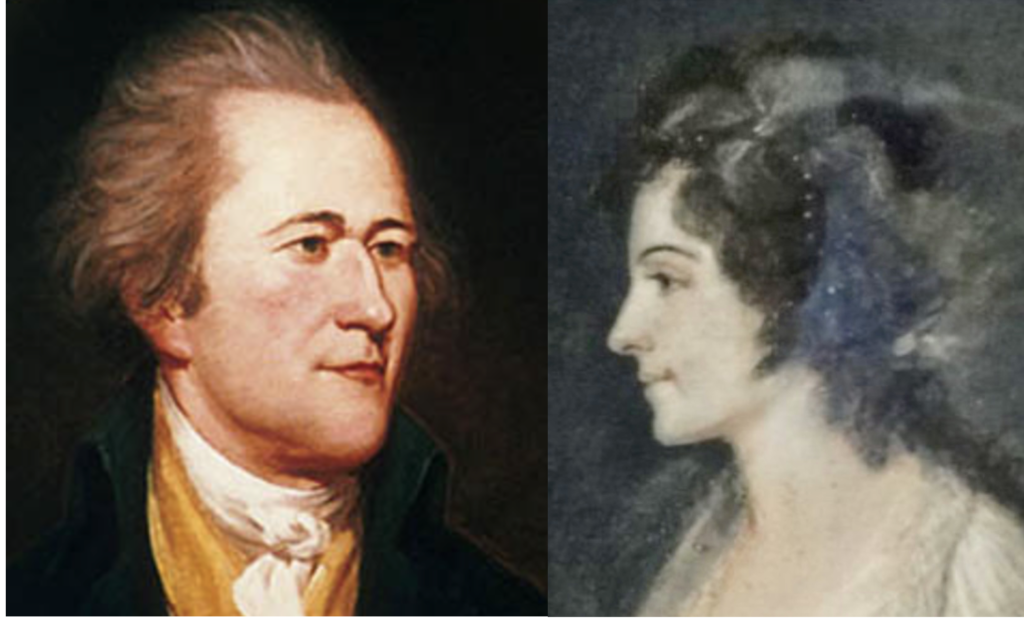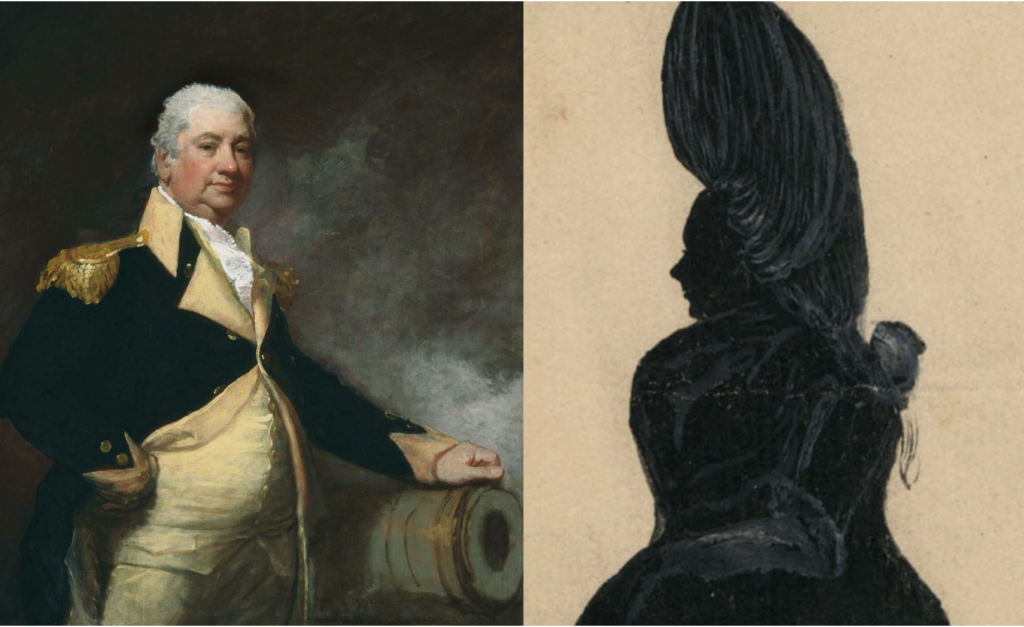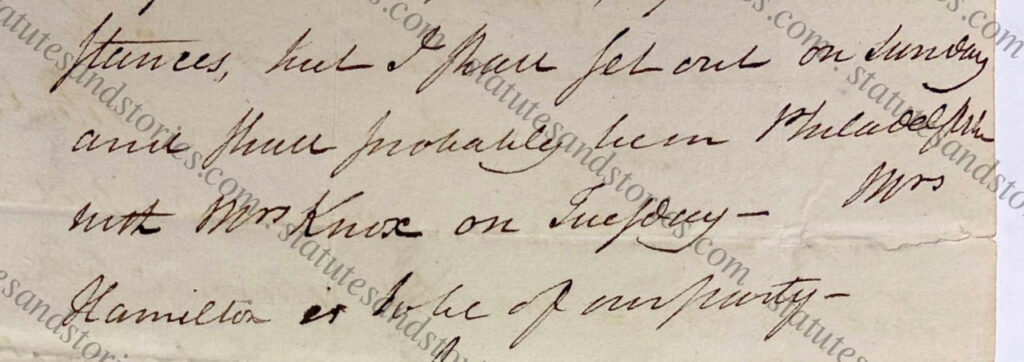Eliza Hamilton’s Visit to the Constitutional Convention (Part II)
Did Eliza travel with Henry and Lucy Knox to Philadelphia in June of 1787?
Although Alexander Hamilton never ran for president, there is no shortage of biographies about his career. Beginning with his son, John Church Hamilton, the extensive papers of Alexander Hamilton have been scrutinized by generations of historians.[1] Yet, no biographer has claimed that Elizabeth Hamilton (also known as Betsey or Eliza) ever visited Philadelphia during the Constitutional Convention.
Newly revealed evidence suggests that Eliza in fact visited Philadelphia in June of 1787. This discovery is significant for several reasons, including the fact that Alexander presented the “Hamilton Plan” during an all-day speech at the Constitutional Convention on June 18. What role might the wives have played in Philadelphia? It is only fitting that Eliza’s story should be fully uncovered.
This article is the second in a three-part series setting forth the Eliza “Philadelphia Surprise” Thesis. The first article, Part I, summarizes the evidence of how Eliza could have made the trip to Philadelphia without her husband, Alexander. According to a newly uncovered letter dated 8 June 1787, it appears that Eliza traveled to Philadelphia with fellow New Yorkers, Henry Knox and his wife, Lucy.[2]
As suggested in Part I, Henry Knox was an ideal traveling companion for Eliza. Knox was the “Secretary at War” under the Articles of Confederation. Moreover, Henry was traveling to Philadelphia with his wife, Lucy Knox. It is also evident that the Hamilton family was friendly with the Knox family, who in 1787 likely lived within walking distance of each other in lower Manhattan.[3]
Pictured above are portraits of Alexander Hamilton and Eliza Hamilton. Pictured below is a portrait of Henry Knox beside a silhouette of his wife, Lucy Flucker Knox.
Fifty-five delegates attended the Constitutional Convention which met from May to September of 1787 in Philadelphia.[4] Apart from the Pennsylvania delegates who lived in Philadelphia, historians have estimated that as many as nine delegates from six states may have been accompanied by their spouses.[5] Eliza, however, would have been a rare example of a spouse who traveled without their husband to Philadelphia.
The Eliza Philadelphia Surprise Thesis is based on three assumptions. Henry Knox’s letter of June 8 indicates that Mrs. Hamilton “is to be of our party” traveling to Philadelphia. In order to prove Eliza’s trip to Philadelphia, it is necessary to establish: 1) that Henry and Lucy Knox actually took the intended trip described in Knox’s June 8 letter, 2) that Eliza was the “Mrs. Hamilton” described in the Knox letter, and 3) that Eliza did in fact travel to Philadelphia with Henry and Lucy Knox, as planned.
This post, Part II, explores the evidence that confirms this first assumption. There is overwhelming evidence establishing that both Henry and Lucy Knox traveled from New York to Philadelphia in June of 1787. Part III will continue with a discussion of the remaining assumptions behind the Eliza Philadelphia Surprise Thesis. Part III will also set forth as yet unanswered questions for future research.
Henry Knox’s June 8 letter to Rufus King
Henry Knox began his June 8 letter by thanking Massachusetts delegate Rufus King for his letter of June 3.[6] Knox also provides news from Massachusetts, along with updates about New Hampshire and Rhode Island – which had not yet sent delegates to the Convention.[7] Knox bemoans the “effects of a headstrong democracy” in Massachusetts. He opines that it is the Constitutional Convention “to whom the thinking part of the community” are looking for solutions. “God grant that they may not be disappointed.”
At the bottom of the three-page letter, Knox mentions that his return trip to Philadelphia had been delayed by sundry circumstances. Nevertheless, Knox indicates that “I shall set out on Sunday [June 10] and shall probably be in Philadelphia with Mrs. Knox on Tuesday [June 12].” Knox concludes the letter by stating that “Mrs. Hamilton is to be of our party.”
Proof that Henry and Lucy traveled to Philadelphia – William Knox letters to Henry
The extensive papers of Henry Knox are primarily held at the Gilder Lehrman Institute, the New-York Historical Society, the New York Public Library, the Massachusetts Historical Society, and the Library of Congress. A search of these records conclusively establishes that Henry and Lucy Knox traveled to Philadelphia in June of 1787.[8]
One question confronting Henry and Lucy would have been what to do with their young children? The answer is that their oldest daughter, 11-year-old Lucy, traveled to Philadelphia with her parents. The other children were left in New York in the care of Henry’s brother, William.
By letter dated June 14, William wrote to his brother Henry that “the children are perfectly well.” William concludes the letter by sending his love to Mrs. Knox. He also tells Henry to kiss little Lucy for me.
Four days later, on June 18, William wrote another letter indicating that “Marcus and Carlone are as perfect in health as when you left them.”[9] William was also happy to report that Henry and Lucy’s “little daughter,” Julie, had recovered so as “to prevent any anxiety you and my sister might have….”
Similarly, a June 25th letter from William to Henry provides further confirmation that Henry and Lucy Knox traveled to Philadelphia in June. William begins the letter by indicating, “My dear brother, I received a line from you dated at Philadelphia on Friday….” (emphasis added). As was the case with other letters between the brothers, William reported on the health of the Knox children. “Marcus & Julie are as well as when you left them.” Caroline was teething and “uneasy” with her “tooth making its way through the gum,” but she did not have any fever or symptoms, “therefore you need not be unhappy on her account or accelerate your progress homeward.”
Additional Proof that Henry and Lucy traveled to Philadelphia
Further confirmation that Henry and Lucy Knox traveled to Philadelphia in June of 1787 is an unequivocal letter from George Washington to Lucy Knox. On June 30, Washington sent a short note to Lucy Knox which is copied below:
[Philadelphia] Saturday near 11 Oclock [30 June 1787]
General Washington presents his Compliments and best wishes to Mrs Knox. Business in the earlier part of the Morning, and company since, having deprived him of the pleasure of taking a personal leave of her begs leave, before he goes to the Convention; to wish Mrs. Knox a pleasant Journey, and happy meeting with her family in New York.
This letter makes clear that Henry and Lucy departed Philadelphia on or about June 30.[10] Washington was unable to see them off, but took the time to write a personal note wishing Mrs. Knox a pleasant return trip to New York.
One final piece of evidence is instructive. By letter dated 11 July, Rufus King wrote to Henry Knox complaining that the Convention had not progressed “a single step since you left us…”[11] King jokes that he would have “escaped much vexation” had he returned to New York “with you or with our very able and sagacious friend Hamilton.”
Upon close examination of King’s July 11 letter, it is reasonable to ask: Did Henry and Lucy Knox return to New York with Alexander and Eliza? This post will continue in Part III with proof that Eliza Hamilton traveled to Philadelphia in June of 1787.
Endnotes
[1] Between 1834-1840, John Church Hamilton wrote an initial two-volume biography of his father, The Life of Alexander Hamilton. Between 1850-1851. John Church also compiled a seven-volume collection of Hamilton papers, The Works of Alexander Hamilton: Containing his Correspondence, and his Political and Official Writings, published by order of Congress beginning in 1850, under the authority of the Joint Library Committee of Congress. Between 1857 to 1864 John Church published a seven-volume biography, titled Life of Alexander Hamilton: A History of the Republic of the United States of America. In 1910, Hamilton’s grandson, Allan McLane Hamilton published The Intimate Life of Alexander Hamilton based on additional family letters and documents which not yet previously been published. U.S. Senator and historian, Henry Cabot Lodge, published a biography of Hamilton in 1882, followed by the twelve-volume The Works of Alexander Hamilton. The authoritative twenty-seven volumes of The Papers of Alexander Hamilton were edited by Professor Harold C. Syrett, published from 1957 to 1987.
[2] Prior to the Revolutionary War Henry Knox was a bookstore owner from Boston. On March 8, 1785 Knox was appointed to head the War Department. Mark Puls, Henry Knox: Visionary General of the American Revolution, 188 (2008). This appointment forced Knox to move from his home state of Massachusetts to New York City in April of 1785 with his wife Lucy and three children. Puls, 190.
[3] In a letter to Henry Knox dated 11 July 1787, Rufus King described Hamilton as “our very able and sagacious friend.” Hutson, 163. After learning of Hamilton’s tragic death in in 1804, Knox broke down and cried inconsolably at the loss. Puls, 245.
[4] Richard Beeman, Plain, Honest Men: The Making of the American Constitution (2009), 64. Twelve of the original thirteen states, with the exception of Rhode Island, selected seventy-four delegates to attend the Convention. Christopher Collier & James Lincoln Collier, Decision in Philadelphia (2007), 103. State delegations in Philadelphia ranged in size from two (New Hampshire) to eight (Pennsylvania). National Park Service, 1787: The Day-to-Day Story of the Constitutional Convention (1987), 7-8; Max Farrand, The Records of the Federal Convention of 1787, III:557-558.
[5] John R. Vile, The Constitutional Convention of 1787: A Comprehensive Encyclopedia of America’s Founding (2005), 1;217; David O. Stewart, The Summer of 1787: The Men Who Invented the Constitution (2007), 44. Vile identifies seven delegates who brought their spouses to Philadelphia: Charles Cotesworth Pinckney (SC), Elbridge Gerry (MA), Rufus King (MA), William Houston (NJ), Edmund Randolph (VA), Pierce Butler (SC) and Alexander Hamilton (NY). Vile further suspects that two other spouses may have traveled to Philadelphia: the wives of Luther Martin (MD) and John Rutledge (SC).
[6] Knox was busy writing letters in the early months of the Convention. Max Farrand’s Records of the Constitutional Convention and James Hutson’s Supplement to Max Farrand identify the following correspondence to and from Knox: Henry Knox to John Sullivan dated 21 May, Rufus King to Henry Knox dated 27 May, Knox to Washington dated 29 May, Washington to Knox dated 31 May, Rufus King to Knox dated 3 June, King to Knox dated 11 July, and Washinton to Knox dated 19 August. Yet, neither Farrand nor Hutson mention that 8 June letter from Knox to King which is the subject of this post.
[7] On June 27 New Hampshire would eventually appoint two delegates to the Convention, John Langdon and Nicholas Gilman. They would not arrive until July 23. Farrand, III:588.
[8] Special thanks is owed to intrepid colleagues Paul Levinson and Eunho Jung who help make this research possible. Assistance was also provided by Dan Hinchen from the Massachusetts Historical Society, Crystal Toscano and Meredith Mann from the New-York Historical Society, Molly Riddick at Gilder Lehrman, and the short-staffed team at Independence National Historical Park, Stefan Kosovych and Maxim Bouchard.
[9] In a second letter dated June 18, William sends “my love to Mrs. Knox & Lucy,” further confirming that both Mrs. Lucy Knox and their daughter Lucy traveled to Philadelphia.
[10] https://founders.archives.gov/documents/Washington/04-05-02-0219
[11] Hutson, 163.






